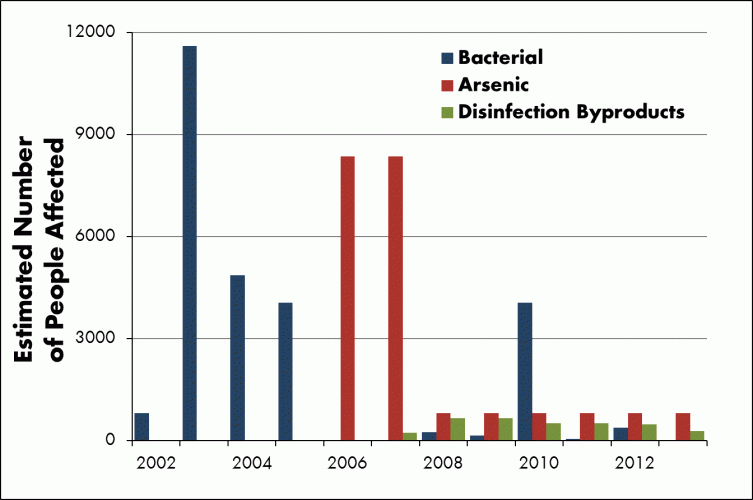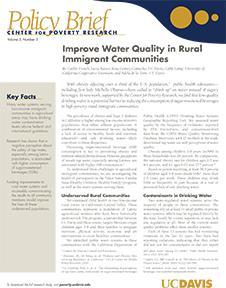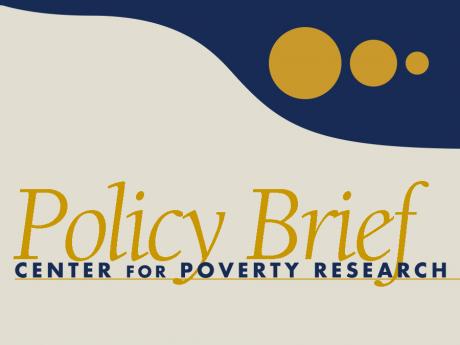Improving Water Quality in Rural Immigrant Communities
By Caitlin French, Lucia Kaiser, Rosa Gomez-Camacho, UC Davis; Cathi Lamp, University of California Cooperative Extension; and Adela de la Torre, UC Davis
With obesity affecting over a third of the U.S. population, public health advocates—including first lady Michelle Obama—have called to “drink up” on water instead of sugary beverages. In new work, supported by the Center for Poverty Research, we find that low-quality drinking water is a potential barrier to reducing the consumption of sugar-sweetened beverages in high-poverty rural immigrant communities.
Key Facts
- Many water systems serving low-income immigrant communities in agricultural areas may have drinking water contamination levels above federal and international guidelines.
- Research has shown that a negative perception about the safety of tap water, especially among Latino populations, is associated with higher consumption of sugar-sweetened beverages (SSBs).
- Funding improvements to rural water systems and accessibly communicating the results to all community members would improve the lives of these underserved populations.
The prevalence of obesity and Type 2 diabetes in California is higher among low-income minority populations than white affluent populations. A combination of environmental factors, including a lack of access to healthy foods and nutrition education[1]—and safe drinking water—likely contribute to these disparities.
Decreasing sugar-sweetened beverage (SSB) consumption is key to preventing obesity and nutrition-related chronic disease. However, perceptions of unsafe tap water, especially among Latinos, are associated with higher SSB consumption.[2]
To understand these challenges in agricultural immigrant communities, we are investigating the health of participants in the Niños Sanos, Familia Sana (Healthy Children, Healthy Family) program, as well as the water systems serving them.
Underserved Rural Communities
We examined child health in two low-income rural towns in California’s Central Valley. These communities represent a population of Latino agricultural workers who have been historically underserved. The program, a partnership between UC Davis and these towns, targets Mexican-origin children ages 3-8 and their families to integrate nutrition, physical activity, economic and art interventions to create healthier communities.
We identified public water systems in these communities with the California Department of Public Health (CDPH) Drinking Water Systems Geographic Reporting Tool. We assessed water quality by the frequency of violations reported by EPA EnviroFacts, and contaminant-level data from the CDPH Water Quality Monitoring Database. Interviews with 27 mothers in the study determined tap water use and perceptions of water quality.
Obesity among children 3-8 years (n=599) in these households was 28 percent. By comparison, the national obesity rate for children ages 2-5 was 8.4 percent, and for ages 6-11 was 17.7 percent.[3]
Based on parent reporting, at least 38.5 percent of children aged 3-8 years drank SSBs[4] more than 2-3 times per week. These children may drink SSBs so frequently in part because of a real or perceived lack of safe drinking water.
Contaminants in Drinking Water
Two state-regulated water systems serve the majority of people in these communities. The remaining rely on at least 11 small public or private water systems, which may be regulated directly by the state, locally by county regulators, or may lack any regulation at all. Most of the current water quality problems affect these smaller systems.
Each of these 13 systems has had monitoring violations in the last 12 years. Two have had reporting violations, indicating that they either did not test for contaminants or did not report findings to those they serve.
The Environmental Protection Agency (EPA) sets primary Maximum Contaminant Levels (MCLs) for contaminants considered to be health risks, and secondary non-mandatory MCLs for contaminants affecting taste, color and smell.
Primary MCLs pose real health risks. At very high exposures, arsenic causes serious effects—including skin lesions, cancer, and blindness—but the effects of chronic low-level exposure may include heightened risk for type 2 diabetes. Disinfectants, such as chlorine, remove bacteria, but harmful byproducts sometimes result.
Perceptions of Unsafe Water
All 27 mothers interviewed reported avoiding drinking tap water, citing its unpleasant taste, dirty or yellow appearance, excessive iron and/or general contamination. These comments are consistent with high mineral content in samples from the largest water system serving this community. These minerals—manganese and iron—are considered secondary contaminants and do not have enforceable limits set by the EPA.
Apart from contributing to negative perceptions, the World Health Organization (WHO) has set health benchmarks for manganese that these samples exceeded. The neurotoxic effects of manganese and arsenic at chronic low-level exposures warrant further investigation.
Most of these women reported relying instead on purchased and, to a lesser extent, home-filtered water for drinking and cooking. This additional cost represents an extra burden.
Rethinking Water Issues
Safe tap water should be assured for all communities. Disadvantaged communities, like those in this study, have limited means to purchase water from alternative sources and also cannot improve and maintain their water treatment systems. Increased state funds to agencies already working to identify who is at risk would bring more small water systems into compliance.
To improve information about unregulated systems, subsidies for home water filters and/or testing costs could be offered to private well owners in exchange for testing reports. In addition, outreach efforts should be expanded to target private systems in known problem areas, especially those that are severely disadvantaged.
Removing primary contaminants may not matter if perceptions and drinkability are not improved. Reduced secondary contaminants could increase confidence in the public water supply.
These improvements must also be clearly communicated. A simple step could be to require water system operators to send clear water quality reports not only to property owners, who currently receive them, but also to renters in their preferred language to provide clear and interpretable information to affected residents. Social marketing campaigns would also create greater awareness of these issues and strategies to improve water safety.
Caitlin French is a Ph.D. student in Nutritional Biology at UC Davis.
Lucia Kaiser is a Cooperative Extension nutrition specialist and registered dietitian. She earned her M.S. and Ph.D. in the Department of Nutrition at UC Davis.
Rosa Gomez-Camacho is a post-doctoral fellow at the Center for Transnational Health at UC Davis.
Cathi Lamp is a nutrition advisor in Tulare and Kings Counties who works on community solutions to improve nutrition in low-income families.
Adela de la Torre, an agricultural economist, is a professor in Chicana/o Studies and director of the Center for Transnational Health at UC Davis.
[1] Diamant, AL, SH Babey, et. al. “Diabetes and Obesity: Two Growing Epidemics in California.” UCLA Center for Health Policy Research, 2010.
[2] S.J. Onufrak, Park, S., et. al. “The relationship of perceptions of tap water safety with intake of sugar-sweetened beverages and plain water among US adults.” Public Health Nutrition. 2014: 17(1), 179-185.
[3] Ogden, CL, MD Carroll, et. al. “Prevalence of Obesity in the United States.” JAMA. 2014: 312(2):189-190.
[4] SSB included soda and other bottled sugar-sweetened beverages, but excluded homemade drinks.
For Further
Reading
Babey SH, Wolstein J, Goldstein H. (2013). “Still Bubbling Over:
California Adolescents Drinking More Soda and Other
Sugar-Sweetened Beverages.” UCLA Center for Health Policy
Research and California Center for Public Health Advocacy.
Balazs, C. L., Morello-Frosch, R., Hubbard, A. E., & Ray, I. (2012). Environmental justice implications of arsenic contamination in California’s San Joaquin Valley: a cross-sectional, cluster-design examining exposure and compliance in community drinking water systems. Environ Health, 11, 84. doi: 10.1186/1476-069X-11-84.
Balazs, C., Morello-Frosch, R., Hubbard, A., & Ray, I. (2011). Social Disparities in Nitrate Contaminated Drinking Water in California’s San Joaquin Valley. Environ Health Perspect. doi: 10.1289/ehp.1002878.
California Department of Public Health. (2013). “Small Water System Program Goal Implementation Plan.”
California Department of Water Resources. (2014). “Californians Without Safe Water and Sanitation Update 2013.” (Draft). 4 April.
DeSimone, L.A., Hamilton, P.A., and Gilliom, R.J. (2009). “The quality of our nation’s waters—Quality of water from domestic wells in principal aquifers of the United States, 1991–2004—Overview of major findings” U.S. Geological Survey Circular #1332.
Diamant AL, Babey SH, Wolstein J and Jones M. (2010). “Diabetes and Obesity: Two Growing Epidemics” in California. Los Angeles, CA: UCLA Center for Health Policy Research.
Hu, FB. “Resolved: there is sufficient scientific evidence that decreasing sugar-sweetened beverage consumption will reduce the prevalence of obesity and obesity-related diseases.” Obesity Review. 2013.
Kaiser LL, Martin AC, Steinberg FM. (2010). “Diabetes in farmworkers: What are the implications for occupational health and safety programs?” California Agriculture. Jan-Mar: 17-21.
Ogden CL, Lamb MM, Carroll MD, Flegal KM. (2010). “Obesity and socioeconomic status in adults: United States 1988–1994 and 2005–2008.” NCHS data brief no 50. Hyattsville, MD: National Center for Health Statistics.
Onufrak, S. J., Park, S., Sharkey, J. R., & Sherry, B. (2014). The relationship of perceptions of tap water safety with intake of sugar-sweetened beverages and plain water among US adults. Public Health Nutrition. 17(1), 179-185. doi: 10.1017/S1368980012004600.
Scherzer, T., Barker, J. C., Poliick, H., & Weintraub, J.A. (2010). Water consumption beliefs and prac-tices in a rural Latino community: implications for fluoridation. J Public Health Dent, 70(4), 337-323. doi: 10.1111/j.1752-7325.2010.00193.x.
United States Department of Agriculture. (2010). “Dietary Guidelines for Americans.”
United States Environmental Protection Agency Office of Water. (2009). “Water on Tap: What You Need to Know.” Retrieved 22 March 2014. http://www.epa.gov/safewater/wot/pdfs/book_waterontap_full.pdf.
#povertyresearch












